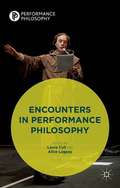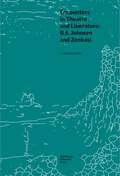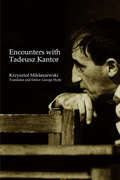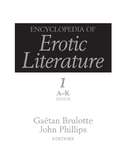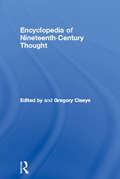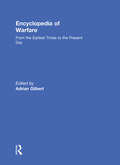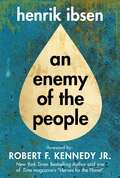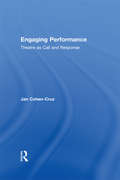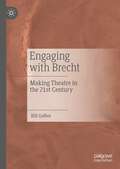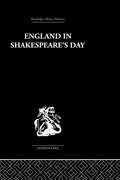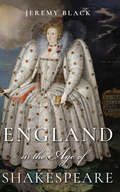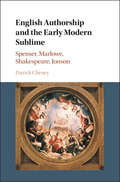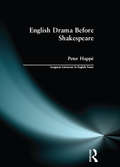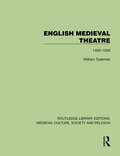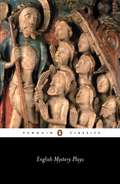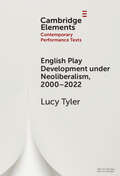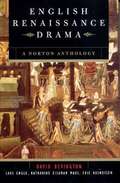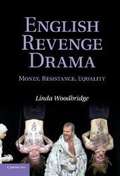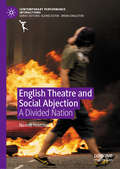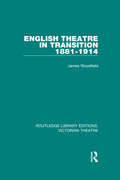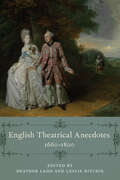- Table View
- List View
Encounters in Performance Philosophy
by Laura Cull Alice LagaayEncounters in Performance Philosophy is a collection of 14 essays by international researchers which demonstrates the vitality of the field of Performance Philosophy. The essays address a wide range of concerns common to performance and philosophy including: the body, language, performativity, mimesis and tragedy.
Encounters in Theatre and Liberature: B.S. Johnson and Zenkasi (Topographies of (Post)Modernity: Studies in 20th and 21st Century Literature in English)
by Katarzyna BielaIn his essay-manifesto of 1999, Zenon Fajfer defined liberature – a literary genre encompassing works whose authors intentionally design the shape of the book, so that it matches their textual message. Extending beyond the growing literary research on liberature, this book presents the theatrical contexts of the genre. Grounded in original archival research, it discusses the theatre practice of Zenon Fajfer and Katarzyna Bazarnik (Zenkasi), as well as the post-war British avant-garde author, B.S. Johnson, whom they see as as a liberatic author avant la lettre. Tracking the connections between their work work in different media, the monograph considers how their theatrical experience may be related to the invention of unconventional aesthetic solutions in literature.
Encounters with Tadeusz Kantor (Routledge Harwood Polish And East European Theatre Archive Ser.)
by Krzysztof MiklaszewskiAn invaluable collection of documents and discussions of the work of one of the most significant theatre practitioners of the last fifty years.This unique set of reminiscences, written by one of the actors who worked closely with Kantor over a long period of time, ranges from the anecdotal to the theoretical. Kantor's work offers some of the most disconcerting allegories of Modernism and a quintessential expression of the unconscious during a bitter period of human history. Kantor's stern but affectionate guardianship of his troupe of travelling players comes off Miklaszewski's pages with warmth, humanity and humour.
Encyclopedia of Erotic Literature
by John Phillips GaThe Encyclopedia of Erotic Literature is a two-volume work that contains some 540 entries on erotic literature on an international scale. The Encyclopedia has an unprecedented scope, the first scholarly reference resource to bring the field together in all its fascinating variety. The entries examine the history of the literature in different countries and languages from classical antiquity to the present day, individual writers from around the world (not all of them necessarily known as specialist writers of erotic literature), significant works, genres and critical approaches, and general themes pertinent to erotic literature (nudity, prostitution, etc.). The definition of erotic literature is broad, encompassing all the material recognized in the study of the field: not just fiction in all genres (novels, poetry, short stories, drama), but also essays, autobiographies, treatises and sex manuals from different cultures. This Encyclopedia deals with sexually explicit texts characterized by sexual representations and suggestions. All types of sexuality are included. For more information about the title and the editors, go to: http://www.londonmet.ac.uk/news/latest-news/erotic-encyclopedia-edited-by-london-met-professor.cfm/
Encyclopedia of Nineteenth Century Thought
by Gregory ClaeysEncyclopedia of Nineteenth Century Thought provides essential information on, and a critical interpretation of, nineteenth-century thought and nineteenth-century thinkers. The project takes as its temporal boundary the period 1789 to 1914. Encyclopedia of Nineteenth Century Thought primarily covers social and political thinking, but key entries also survey science, religion, law, art, concepts of modernity, the body and health, and so on, and thereby take into account all of the key developments in the intellectual history of the period. The encyclopedia is alphabetically organized, and consists of:* principal entries, divided into ideas (4000 words) and persons (2500 words)* subsidiary entries of 1000 words, which are entirely biographical* informational entries of 500 words, which are also biographical.
Encyclopedia of Warfare: From the Earliest Times to the Present Day
by Adrian GilbertThe Encyclopedia of Warfare is a chronological account of the development of warfare since the beginnings of recorded history. The book is organized in 10 chapters, each of which looks at a particular era in warfare from the ancient world to the present. Each chapter includes color maps of key campaigns, as well as commentary on battles, personalities, troops, and equipment. Sidebars throughout the main narrative focus on noteworthy aspects of the history of conflict. Through its chronological organization and ample use of maps, the Encyclopedia also clearly conveys the link between war and world geographical history. A thorough yet concise exploration of combat throughout human history, this fascinating and informative reference work is an outstanding addition to any library collection.
Enemy of the People: A Play In Five Acts
by Henrik IbsenEnvironmentalist, activist, and attorney Robert F. Kennedy Jr. contributes a foreword to this Skyhorse edition of Norwegian playwright Henrik Ibsen&’s renowned 1882 play. Regarded as one of the foremost playwrights of the nineteenth century, Henrik Ibsen tells the story of the idealist Doctor Thomas Stockmann, the medical officer of a recently opened spa in a small town in southern Norway, who finds that the water is seriously contaminated. He notifies members of the community and initially receives support and thanks for the discovery. Threatened by the possible impact of such a revelation, his brother, the town mayor, conspires with local politicians and the newspaper to suppress the story and pressure Dr. Stockmann to retract his statements. At a public meeting, an attempt is made to keep Dr. Stockmann from speaking, but he launches into a tirade condemning the corruption of the town and the tyranny of the majority. Finding his speech offensive, he is shouted down by the masses and reviled as "an enemy of the people." In his foreword, Kennedy alerts readers to the undeniable fact that the persecution of those who tell uncomfortable truths, which Ibsen described over one hundred years ago, continues to this day and is as relevant now as ever. We face environmental deregulation and degradation, politicians in lobbyists&’ pockets, attacks on facts that are agreed upon by reputable scientists, corporate funded and controlled research, and attempts to impede and suppress whistleblowers. The battle continues and Kennedy joins Ibsen on the front lines.
Engaging Performance: Theatre as call and response
by Jan Cohen-CruzEngaging Performance: Theatre as Call and Response presents a combined analysis and workbook to examine "socially engaged performance." It offers a range of key practical approaches, exercises, and principles for using performance to engage in a variety of social and artistic projects. Author Jan Cohen-Cruz draws on a career of groundbreaking research and work within the fields of political, applied, and community theatre to explore the impact of how differing genres of theatre respond to social "calls." Areas highlighted include: playwrighting and the engaged artist theatre of the oppressed performance as testimonial the place of engaged art in cultural organizing the use of local resources in engaged art revitalizing cities and neighborhoods through engaged performance training of the engaged artist. Cohen-Cruz also draws on the work of major theoreticians, including Bertolt Brecht, Augusto Boal, and Doreen Massey, as well as analyzing in-depth case studies of the work of US practitioners today to illustrate engaged performance in action. Jan Cohen-Cruz is director of Imagining America: Artists and Scholars in Public Life. She is the author of Local Acts: Community-based Performance in the US; the editor of Radical Street Performance; co-editor, with Mady Schutzman, of Playing Boal: Theatre, Therapy, Activism and A Boal Companion; and a University Professor at Syracuse University.
Engaging with Brecht: Making Theatre in the Twenty-first Century
by Bill GelberThis book makes the case for Bertolt Brecht’s continued importance at a time when events of the 21st century cry out for a studied means of producing theatre for social change. Here is a unique step-by-step process for realizing Brecht’s ways of working onstage using the 2015 Texas Tech University production of Brecht’s Mother Courage and Her Children as a model for exploration. Particular Brecht concepts—the epic, Verfremdung, the Fabel, gestus, historicization, literarization, the “Not…but,” Arrangement, and the Separation of the Elements—are explained and applied to scenes and plays. Brecht’s complicated relationship with Konstantin Stanislavsky is also explored in relation to their separate views on acting. For theatrical practitioners and educators, this volume is a record of pedagogical engagement, an empirical study of Brecht’s work in performance at a higher institution of learning using graduate and undergraduate students.
England in Literature
by Scott ForesmanEngland in Literature has eight chronological units presenting a survey of major British writers from the beginning until the present time.
England in Shakespeare's Day
by G B HarrisonFirst published in 1928. This book collects together over one hundred sources by Elizabethan authors which show English life in English literature. Most of them have been selected as much to catch the atmosphere as the moods of the period, and come from the great Elizabethan writers who can transmit the essence of the time. A 'gallery of Elizabethan pictures' rather than a complete survey of life in Shakespeare's day, the spelling and punctuation have been modernized throughout. To enable those who wish to read the extracts in their context, references are given to the most accessible editions.
England in the Age of Shakespeare
by Jeremy BlackHow did it feel to hear Macbeth’s witches chant of "double, double toil and trouble" at a time when magic and witchcraft were as real as anything science had to offer? How were justice and forgiveness understood by the audience who first watched King Lear; how were love and romance viewed by those who first saw Romeo and Juliet? In England in the Age of Shakespeare, Jeremy Black takes readers on a tour of life in the streets, homes, farms, churches, and palaces of the Bard’s era. Panning from play to audience and back again, Black shows how Shakespeare’s plays would have been experienced and interpreted by those who paid to see them. From the dangers of travel to the indignities of everyday life in teeming London, Black explores the jokes, political and economic references, and small asides that Shakespeare’s audiences would have recognized. These moments of recognition often reflected the audience’s own experiences of what it was to, as Hamlet says, "grunt and sweat under a weary life." Black’s clear and sweeping approach seeks to reclaim Shakespeare from the ivory tower and make the plays’ histories more accessible to the public for whom the plays were always intended.
English Authorship and the Early Modern Sublime: Fictions Of Transport In Spenser, Marlowe, Jonson, And Shakespeare
by Patrick CheneyPatrick Cheney's new book places the sublime at the heart of poems and plays in late sixteenth- and early seventeenth-century England. <P><P>Specifically, Cheney argues for the importance of an 'early modern sublime' to the advent of modern authorship in Spenser, Marlowe, Shakespeare, and Jonson. Chapters feature a model of creative excellence and social liberty that helps explain the greatness of the English Renaissance. Cheney's argument revises the received wisdom, which locates the sublime in the eighteenth-century philosophical 'subject'. <P>The book demonstrates that canonical works like The Faerie Queene and King Lear reinvent sublimity as a new standard of authorship. This standard emerges not only in rational, patriotic paradigms of classical and Christian goodness but also in the eternizing greatness of the author's work: free, heightened, ecstatic. Playing a centralizing role in the advent of modern authorship, the early modern sublime becomes a catalyst in the formation of an English canon.<P> The first book to place the sublime at the heart of poems and plays in late sixteenth- and early seventeenth-century England.<P> Links recent work on the classical or medieval sublime and the modern sublime.<P> Introduces a new model of authorship featuring an aesthetics of sublimity focussing on writers such as Edmund Spenser, Christopher Marlowe, William Shakespeare, and Ben Jonson.
English Drama Before Shakespeare (Longman Literature In English Series)
by Peter HappeEnglish Drama before Shakespeare surveys the range of dramatic activity in English up to 1590. The book challenges the traditional divisions between Medieval and Renaissance literature by showing that there was much continuity throughout this period, in spite of many innovations. The range of dramatic activity includes well-known features such as mystery cycles and the interludes, as well as comedy and tragedy. Para-dramatic activity such as the liturgical drama, royal entries and localised or parish drama is also covered. Many of the plays considered are anonymous, but a coherent, biographical view can be taken of the work of known dramatists such as John Heywood, John Bale, and Christopher Marlowe.Peter Happé's study is based upon close reading of selected plays, especially from the mystery cycles and such Elizabethan works as Thomas Kyd's The Spanish Tragedy. It takes account of contemporary research into dramatic form, performance (including some important recent revivals), dramatic sites and early theatre buildings, and the nature of early dramatic texts. Recent changes in outlook generated by the publication of the written records of early drama form part of the book's focus. There is an extensive bibliography covering social and political background, the lives and works of individual authors, and the development of theatrical ideas through the period. The book is aimed at undergraduates, as well as offering an overview for more advanced students and researchers in drama and in related fields of literature and cultural studies.
English Drama of the Early Modern Period 1890-1940 (Longman Literature In English Series)
by Jean ChothiaThe period 1890-1940 was a particularly rich and influential phase in the development of modern English theatre: the age of Wilde and Shaw and a generation of influential actors and managers from Irving and Terry to Guilgud and Olivier.Jean Chothia's study is in two parts beginning with a portrait of the period, setting the narrative context and considering the dramatic social and cultural changes at work during this time. It then focuses on some of the main themes in the theatre, from Shaw and comedy, to the rise of political and radio drama, providing an interpretative framework for the period. This volume will be of great benefit to students and academics of English literature and drama, as it covers the work of the major dramatists of the period as well as considering the dramatic output of literary figures, such as James, Eliot and Lawrence.
English Medieval Theatre: 1400–1500 (Routledge Library Editions: Medieval Culture, Society, & Religion)
by William TydemanOriginally published in 1986, this volume illuminates the predominant theatrical styles of a particular period in dramatic history. It does this by reconstructing – as far as conjecture permits – the manner in which five major plays of the late Middle Ages might have been staged in fifteenth-century Britain. The author draws on his experience in producing medieval plays to discuss the business of staging in a novel way. General conclusions are drawn from specific examples and the qualities which give medieval English drama its idiosyncratic features and appeal are characterized.
English Mystery Plays
by Peter HappéHumour, pathos and suffering, and the culminating drama of the Crucifixion and Resurrection, give these plays a wonderful immediacy. Their action was conceived on a cosmic scale and all the enthusiasm and vitality of their writing is retained to this day. The energies of whole communities, notably at Chester, York and Wakefield, were devoted to their production and they were to influence later dramatists significantly. The grand design of the mystery plays was to celebrate the Christian story from 'The Fall of Lucifer' to the 'Judgement Day', and this volume contains thirty-eight plays, forming in itself a composite cycle and including almost all the incidents common to the extant cycles.
English Play Development under Neoliberalism, 2000–2022 (Elements in Contemporary Performance Texts)
by Lucy TylerEnglish Play Development under Neoliberalism, 2000–2022 is the first study of the institutionalising of English play development practices in the twenty-first century. It identifies the ways in which support for playwrights and text development increased beneficially during the 1990s and 2000s. It assesses bureaucratic institutional dynamics in key English producing houses as they were surveyed by two reports in 2009, and how these were experienced and transformed in the 2010s. The Element identifies in new play development innovations in the commodification and marketisation of new writing, the bureaucratisation of literary management, the structuring and restructuring of dramaturgy according to Fordist, then post-Fordist, conditions, and the necessity for commissioned artists to operate as neoliberal subjects. It concludes with attention to a liberatory horizon for play development in the English context. This title is also available as Open Access on Cambridge Core.
English Poetry And Drama Part-2
by Directorate of Distance Education Annamalai University CuddaloreThe course on “Poetry and Drama” aims at introducing the learner to some of the splendid specimens of poetry that are thought-provoking and inspiring. It also acquaints the learner with a classic comedy of Shakespeare and some of the short modern plays that deal with modern problems. Moreover, the student can learn the usage of modern English idiom.
English Poetry And Drama Part-II Units I-V
by Directorate of Distance Education Annamalai University Tamil NaduThe course on “Poetry and Drama” aims at introducing the learner to some of the splendid specimens of poetry that are thought-provoking and inspiring. It also acquaints the learner with a classic comedy of Shakespeare and some of the short modern plays that deal with modern problems. Moreover, the student can learn the usage of modern English idiom.
English Renaissance Drama: A Norton Anthology
by David Bevington Eric Rasmussen Katharine Eisaman Maus Lars EnglePopular in their own time, the 27 plays included here—by Christopher Marlowe, Ben Jonson, John Webster, Thomas Middleton, among many others—reveal why these playwrights' achievements, like Shakespeare's, deserve reading, teaching, and performing afresh in our time. Edited by a team of exceptional scholars and teachers, this anthology opens an extraordinary tradition in drama to new readers and audiences.
English Revenge Drama: Money, Resistance, Equality
by Linda WoodbridgeVengeance permeates English Renaissance drama - for example, it crops up in all but two of Shakespeare's plays. This book explores why a supposedly forgiving Christian culture should have relished such bloodthirsty, vengeful plays. A clue lies in the plays' passion for fairness, a preoccupation suggesting widespread resentment of systemic unfairness - legal, economic, political, and social. Revengers' precise equivalents - the father of two beheaded sons obliges his enemy to eat her two sons' heads - are vigilante versions of Elizabethan law, where penalties suit the crimes: thieves' hands were cut off, scolds' tongues bridled. The revengers' language of 'paying' hints at the operation of revenge in the service of economic redress. Revenge makes contact with resistance theory, justifying overthrow of tyrants, and some revengers challenge the fundamental inequity of social class. Woodbridge demonstrates how, for all their sensationalism, their macabre comedy and outlandish gore, Renaissance revenge plays do some serious cultural work.
English Theatre and Social Abjection: A Divided Nation (Contemporary Performance InterActions)
by Nadine HoldsworthFocusing on contemporary English theatre, this book asks a series of questions: How has theatre contributed to understandings of the North-South divide? What have theatrical treatments of riots offered to wider debates about their causes and consequences? Has theatre been able to intervene in the social unease around Gypsy and Traveller communities? How has theatre challenged white privilege and the persistent denigration of black citizens? In approaching these questions, this book argues that the nation is blighted by a number of internal rifts that pit people against each other in ways that cast particular groups as threats to the nation, as unruly or demeaned citizens – as ‘social abjects’. It interrogates how those divisions are generated and circulated in public discourse and how theatre offers up counter-hegemonic and resistant practices that question and challenge negative stigmatization, but also how theatre can contribute to the recirculation of problematic cultural imaginaries.
English Theatre in Transition 1881-1914 (Routledge Library Editions: Victorian Theatre #6)
by James WoodfieldOriginally published in 1984. The turn of the nineteenth and twentieth centuries was a time of considerable change in the English theatre. Victorian attitudes were shocked or shattered by the new drama of Ibsen; the major figure of George Bernard Shaw dominated the period; theatre censorship was the subject of a long and furious contest; and staging conventions changed from the spectacular stylings of Irving and Beerbohm Tree to the masking and statuesque styles of Isadora Duncan and the inner realism of Stanislavsky. This book traces the activities of the leading figures in the English theatre, notably William Archer who introduced Ibsen to this country and who became one of the main promoters of the idea of a National Theatre. Other personalities discussed include Harley Granville Barker, particularly his association with Shaw at the Court Theatre and his part in campaigns against censorship and for changes in the staging of Shakespeare, and Edward Gordon Craig, whose rebellion against the Victorian theatre took and anti-realist direction. This is a stimulating account of the background to the modern English theatre which can only increase appreciation of its standard and variety.
English Theatrical Anecdotes, 1660-1800 (Performing Celebrity)
by Fiona Ritchie Leslie Ritchie Michael Burden Danielle Bobker Chelsea Phillips Máire MacNeill Heather Ladd Nevena Martinovic Seth Wilson Elaine McGirr Amanda Weldy BoydThe essays in English Theatrical Anecdotes, 1660-1800 explore the theatrical anecdote’s role in the construction of stage fame in England’s emergent celebrity culture during the long eighteenth century, as well as the challenges of employing such anecdotes in theatre scholarship today. This collection showcases scholarship that complicates the theatrical anecdote and shows its many sides and applications beyond the expected comic punch. Discussing anecdotal narratives about theatre people as producing, maintaining, and sometimes toppling individual fame, this book crucially investigates a key mechanism of celebrity in the long eighteenth century that reaches into the nineteenth century and beyond. The anecdote erases boundaries between public and private and fictionalizing the individual in ways deeply familiar to twenty-first century celebrity culture.
